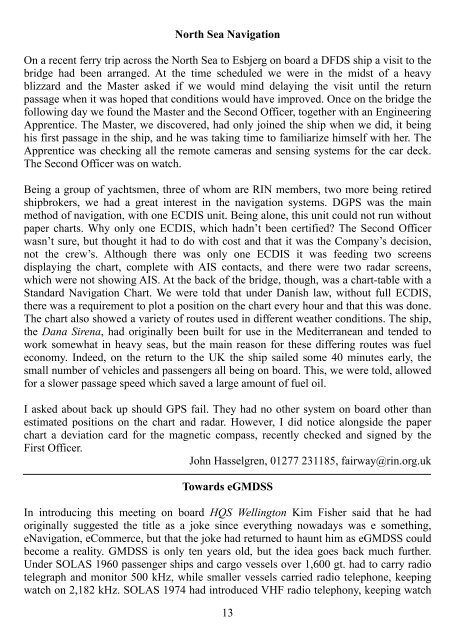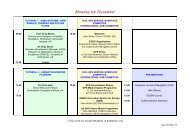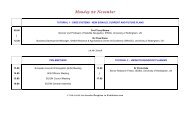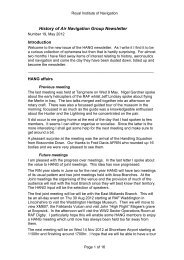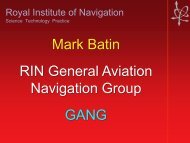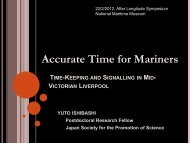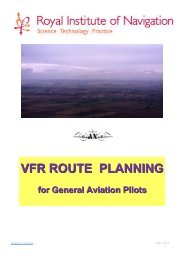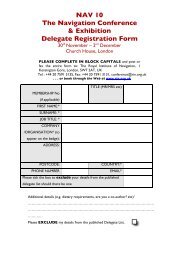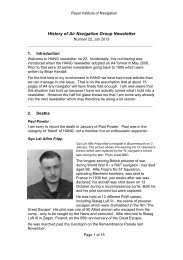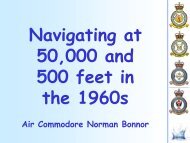Fairway 30 - Royal Institute of Navigation
Fairway 30 - Royal Institute of Navigation
Fairway 30 - Royal Institute of Navigation
You also want an ePaper? Increase the reach of your titles
YUMPU automatically turns print PDFs into web optimized ePapers that Google loves.
North Sea <strong>Navigation</strong><br />
On a recent ferry trip across the North Sea to Esbjerg on board a DFDS ship a visit to the<br />
bridge had been arranged. At the time scheduled we were in the midst <strong>of</strong> a heavy<br />
blizzard and the Master asked if we would mind delaying the visit until the return<br />
passage when it was hoped that conditions would have improved. Once on the bridge the<br />
following day we found the Master and the Second Officer, together with an Engineering<br />
Apprentice. The Master, we discovered, had only joined the ship when we did, it being<br />
his first passage in the ship, and he was taking time to familiarize himself with her. The<br />
Apprentice was checking all the remote cameras and sensing systems for the car deck.<br />
The Second Officer was on watch.<br />
Being a group <strong>of</strong> yachtsmen, three <strong>of</strong> whom are RIN members, two more being retired<br />
shipbrokers, we had a great interest in the navigation systems. DGPS was the main<br />
method <strong>of</strong> navigation, with one ECDIS unit. Being alone, this unit could not run without<br />
paper charts. Why only one ECDIS, which hadn’t been certified? The Second Officer<br />
wasn’t sure, but thought it had to do with cost and that it was the Company’s decision,<br />
not the crew’s. Although there was only one ECDIS it was feeding two screens<br />
displaying the chart, complete with AIS contacts, and there were two radar screens,<br />
which were not showing AIS. At the back <strong>of</strong> the bridge, though, was a chart-table with a<br />
Standard <strong>Navigation</strong> Chart. We were told that under Danish law, without full ECDIS,<br />
there was a requirement to plot a position on the chart every hour and that this was done.<br />
The chart also showed a variety <strong>of</strong> routes used in different weather conditions. The ship,<br />
the Dana Sirena, had originally been built for use in the Mediterranean and tended to<br />
work somewhat in heavy seas, but the main reason for these differing routes was fuel<br />
economy. Indeed, on the return to the UK the ship sailed some 40 minutes early, the<br />
small number <strong>of</strong> vehicles and passengers all being on board. This, we were told, allowed<br />
for a slower passage speed which saved a large amount <strong>of</strong> fuel oil.<br />
I asked about back up should GPS fail. They had no other system on board other than<br />
estimated positions on the chart and radar. However, I did notice alongside the paper<br />
chart a deviation card for the magnetic compass, recently checked and signed by the<br />
First Officer.<br />
John Hasselgren, 01277 231185, fairway@rin.org.uk<br />
Towards eGMDSS<br />
In introducing this meeting on board HQS Wellington Kim Fisher said that he had<br />
originally suggested the title as a joke since everything nowadays was e something,<br />
e<strong>Navigation</strong>, eCommerce, but that the joke had returned to haunt him as eGMDSS could<br />
become a reality. GMDSS is only ten years old, but the idea goes back much further.<br />
Under SOLAS 1960 passenger ships and cargo vessels over 1,600 gt. had to carry radio<br />
telegraph and monitor 500 kHz, while smaller vessels carried radio telephone, keeping<br />
watch on 2,182 kHz. SOLAS 1974 had introduced VHF radio telephony, keeping watch<br />
13


